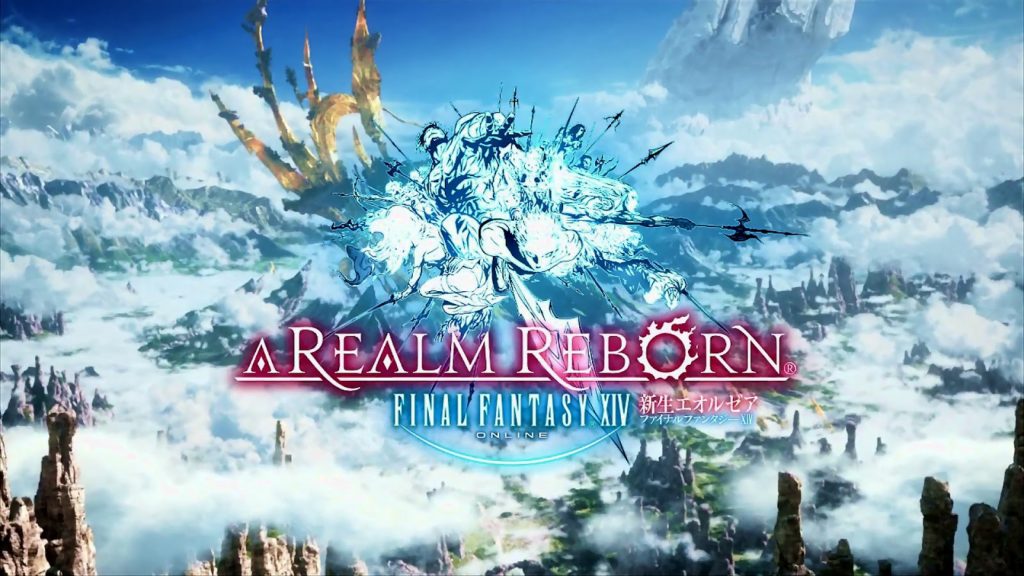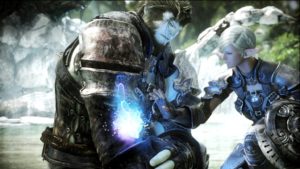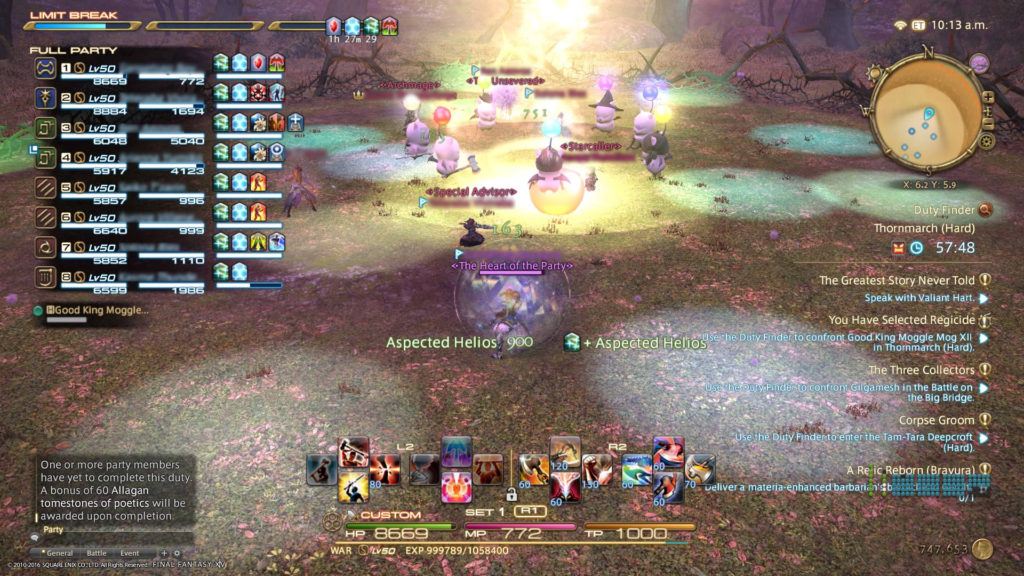How Not to Wipe; or, How MMORPGs Work to Disassociate Gender and Caretaking
As l started working as a games researcher, I found I had some holes in my play history that were hindering my research opportunities. Namely, I had never played a massively multiplayer online game (MMOG or MMO) before, a type of game known for slurping down gobs of one’s time and energy but also, as discussed in games research literature, as fantastic sites of social learning, interaction, and worldbuilding. Thus, I decided to play one when it arrived as a perfect way into the complex genre. As a nearly exclusively console-based player and knowing my unabashed love for the series from whence it comes, it surprises me little that Final Fantasy XIV: A Realm Reborn (hereafter FFXIV) ended up hooking me. However, I started the game in earnest the summer before my master’s thesis year at MIT. Perhaps not such a wise choice.

But! As these things sometimes go, I did indeed also begin my thesis in earnest as well, and I kept finding parallels between what I was writing and what I was playing. Although my time with FFXIV never found its way directly into my thesis, here I’ll make the case I have been itching to make: how the design needs, constraints, and solutions that FFXIV and other MMOs, particularly MMO role-playing games (MMORPGs) can inspire game design that pushes against restrictive assumptions about gender.
First, a digest of my thesis: I argue that mechanics, the interaction points and input options that allow the player to change the game state in some way (such as making an avatar run and jump or selecting matching icons to clear part of the game board), are a part of a game’s storytelling and worldbuilding, along with its art (including sound) and scripted narrative. In my thesis, I investigated that argument through caretaking mechanics, which I defined as mechanics focused at least thematically on helping and caring for others, and which I grouped into three particular manifestations: healing, protection, and building relationships. I considered how these mechanics are featured in (single player) role-playing and action genres and in particular games’ overall aesthetics, characters, and worlds, finding that these mechanics often suggested or imposed an adherence to stereotypical gender roles. These roles cast women and girls as nurturing, emotionally sensitive, and strongly connected to nature, whereas men are the opposite (emotionally distant and more attuned to science and military technology) but are also responsible for delivering (otherwise assumed helpless) women from dangerous situations.
Where my thesis leaves off is where much work begins. My thesis could only make the criticism, but putting that critique into action and seeing more nuance in gender in games is a multifaceted problem. It requires changes in game writing and art (much of which is happening, as more interesting and nuanced characters of both genders emerge) as well as in game design and the mechanical tropes developers implement and players have learned to structure interaction in games. So I wonder, how can healing, protection, relationship building, and any other caretaking mechanics shift in a way that not only broadens who, in a gendered sense, can access them, but also values the intense emotional, sometimes physical, and often mental labor that goes into caring for others?

Here I alleviate any bated breath by returning to my first point: I’ve been playing a lot of an MMORPG. Although I began and continued playing FFXIV for reasons other than my work, I found, through learning the game while maining (bear with me; I’ll explain all of this) a tank class and then taking up a healing one as I had begun writing my thesis (and later a DPS, to round out my repertoire), that this game plays very differently from the single player entries in the series. Indeed, it marks playing each kind of class as uniquely difficult labor, and I have seen closer to a balance of avatar genders in each role, when compared to who’s doing what in the single player games I researched.
As promised, here’s a primer on what any of that means: many MMORPGs work with the tank-heal-damage system. That is, one (or more) player character(s) attracts enemies’ attention as the tank, who has high defense and hit points and is kept alive by the healer(s), as the other characters do damage on the enemy (known as DPS, or damage per second). In FFXIV, any given player character can switch freely between any class (all of which fall within one of the tank-healer-DPS roles) they’ve undertaken, but many players lean towards (or main) one or just a few to play most often, as progressing and properly outfitting a class take quite a bit of time and effort.
Each role has its own ability sets, assigned duties, and expectations on players. Tanks must make sure they keep hold of enemies’ attention, which is diverted by the damage enemies take and other players’ heals that occur near them. Healers must keep tanks alive, as well as any DPS who have taken damage, and they are usually expected to help inflict damage on enemies when there is no healing to be done. The DPS need to maximize the damage they do at all times in order to win the battle. Battles are often designed with timers that mark how long players have to inflict a certain amount of damage, or else the enemy may perform an attack that kills the whole party, resulting in restarting the battle. Everyone is also expected to handle what are (somewhat confusingly here) called mechanics, which are special circumstances in a battle to require players to read, know, and adapt to such shifts; however, if there are special actions to be taken, usually that falls on DPS and healers.

All of these roles are required to find success in an MMO by design; each player has a role to fill and each role has its specified boundaries and requirements. Notably, whereas some MMOs have noticeable changes between male and female characters’ ability statistics (sometimes also based on race) FFXIV does not; rather, players choose roles to focus on the kind of work they are interested in doing. That labor of healing and of the tank’s protection is recognizably difficult, vital, and celebrated. Anecdotally, I’ve found that tanks and healers are rarer than DPS, and so they’re welcomed into most parties and are often the first to get commendations (a system for voting for a player after completing a mission with them, ostensibly for their strong performance).
These systems clearly work in games wherein the whole party/group is controlled by humans, but I think there is potential for some of those design elements in single player games. That could work as (somewhat) simply as having similar role schemes but with computer-controlled party members or as intricately as redesigning the focus of battles in single player games so that healing and protection are crucial mechanics, rather than last resorts if a player has not pushed their character(s) to be offensively powerful.
As for who can access healing and protection mechanics, as Comparative Media Studies’s own Professor Ed Schiappa would advise (as he did my thesis; thank you!), more representation is best: A variety of people can and do take up nurturing, protective, and physically and/or emotionally demanding tasks in real life, and thus why not reflect that range of people in these different roles in games? Thus, personality types and the mechanical statistics that are assigned to them need not be locked to gender. (I make this point in my thesis in relation to Final Fantasy XIII, a sadly much maligned entry in the series that I believe has some really interesting connections between non-standard character types and party-based role-playing mechanics.)
Clearly, I’ve been fascinated both in leisure and in work by my experiences with Final Fantasy XIV. I’m curious to see how the specific design necessities in MMOs might offer different approaches to character interactions in single player games (including relationships, which I couldn’t touch on here). Beyond this, however, is my interest in finding more games that ask players to broaden their perspective on the range of people who exist around them and that challenge players to engage more empathically with others, not only through spoken and written text, visuals, and audio, but also through the actions they perform.
